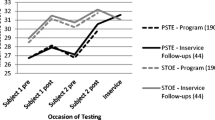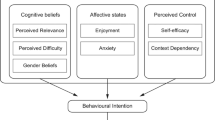Abstract
Every aspect of teaching, including the instructional method, the course content, and the types of assessments, is influenced by teachers’ attitudes and beliefs. Teacher education programs play an important role in the development of beliefs regarding teaching and learning. The purpose of the study was to document pre-service teachers’ views on science, scientists, and science teaching as well as the relations between these views and the offered courses over several years spent in an elementary science teacher training program. The sample consisted of 145 pre-service elementary science teachers who were being trained to teach general science to students in the 6th through 8th grades. The research design was a cross-sectional study. Three different instruments were used to collect the data, namely, the “Draw a Scientist Test”, “Draw a Science Teacher Test”, and “Students’ Views about Science” tests. The elementary science teacher training program influenced pre-service science teachers’ views about science, scientists and science teaching to different degrees. The most pronounced impact of the program was on views about science teaching. Participants’ impressions of science teaching changed from teacher-centered views to student-centered ones. In contrast, participants’ views about scientists and science did not change much. This result could be interpreted as indicating that science teacher training programs do not change views about science and scientists but do change beliefs regarding teaching science.






Similar content being viewed by others
References
Abell SK, Smith DC (1994) What is science? Pre-service elementary teachers’ conceptions of the nature of science. Int J Sci Educ 16:475–487
Adams PE, Krockover GH (1997) Beginning science teacher cognition and its origins in the preservice science teacher program. J Res Sci Teach 34:633–653
American Association for the Advancement of Science (AAAS) (1990) The liberal art of science: agenda for action. Author, Washington, DC
Appleton K, Kindt I (1999) Why teach primary science? Influences on beginning teachers’ practices. Int J Sci Educ 21(2):155–168
Bencze L, Hodson D (1999) Changing practice by changing practice: toward moreauthentic science and science curriculum development. J Res Sci Teach 36:521–539
Bhattacharyya S, Volk T, Lumpe A (2009) The influence of an extensive inquiry-based field experience on pre-service elementary student teachers’ science teaching beliefs. J Sci Teacher Educ 20(3):199–218
Bodzin A, Gehringer M (2001) Can meeting actual scientists change students’ perceptions of scientists? Sci Child 39(1):36–41
BouJaoude S (2000) Conceptions of science teaching revealed by metaphors and by answers to open-ended questions. J Sci Teach Educ 11(2):173–186
Boylan CR, Hill DM, Wallace AR, Wheeler AE (1992) Beyond stereotypes. Sci Educ 76:465–476
Briscoe C, Stout D (1996) Integrating math and science through problem centered learning in methods courses: effects on prospective teachers’ understanding problem solving. J Elementary Sci Educ 8:66–87
Chambers DW (1983) Stereotypic images of the scientist: the Draw-Scientist Test. Sci Educ 67(2):255–265
Cohen J (1960) A coefficient of agreement for nominal scales. Educ Psychol Measur 20(1):37–46
Cohen L, Manion L, Morrison K (2005) Research methods in education, 5th edn. Taylor & Francis e-Library, New York
Connor JR, Scharmann LC (1996) Influence of cooperative early field experience on preservice elementary teachers’ science self-efficacy. Sci Educ 80:419–436
Crawley FE, Salyer BA (1995) Origins of life science teachers’ beliefs underlying curriculum reform in Texas. Sci Educ 79(6):611–635
Cronin-Jones L, Shaw EL (1992) The influence of methods instruction on the beliefs of pre-service elementary and secondary science teachers: preliminary comparative analyses. Sch Sci Math 92(1):14–22
Czerniak CM, Chiarellor L (1990) Teachers’ education for effective science instruction: a social cognitive perspective. J Teach Educ 4(11):49–58
Eick CJ, Reed CJ (2002) What makes an inquiry oriented science teacher? The influence of learning histories on student teacher role identity and practice. Sci Teach Educ 86:401–416
Finson KD (2002) Drawing scientist: what we do and do not know after fifty years of drawings. Sch Sci Math 102(7):335–345
Finson KD (2003) Applicability of the DAST-C to the images of scientists drawn by students of different racial groups. J Element Sci Educ 15(1):15–26
Finson KD, Beaver JB, Crammond RL (1995) Development of a field-test checklist for the draw-a scientist test. Sch Sci Math 95(4):195–205
Finson KD, Pedersen J, Thomas J (2006) Comparing science teaching styles to students’ perceptions of scientists. Sch Sci Math 106(1):8–15
Flick L (1990) Scientist in residence program improving children’s image of science and scientists. Sch Sci Math 90:205–214
Fung YH (2002) A comparative study of primary and secondary school students’ images of scientists. Res Sci Technol Educ 20(2):199–213
Gabel D, Rubba P (1979) Attitude changes of elementary teachers according to the curriculum studies during workshop participation and their role as model science teachers. J Res Sci Teach 16(1):19–24
Hancock ES, Gallard AJ (2004) Preservice science teachers’ beliefs about teaching and learning: the influence of K − 12 field experiences. J Sci Teacher Educ 15:281–291
Haney JJ, Czerniak C, Lumpe AT (1996) Teachers’ beliefs and intentions regarding the implementation of science education reform strands. J Res Sci Teach 33:971–993
Haney JJ, Lumpe AT, Czerniak C, Egan V (2002) From beliefs to actions: the beliefs and actions of teachers implementing change. J Sci Teacher Educ 13(3):171–187
Harlen W, Holroyd C (1997) Primary teachers’ understanding of concepts of science: impact on confidence and teaching. Int J Sci Educ 19(1):93–105
Hashweh MZ (1996) Effects of science teachers’ epistemological beliefs in teaching. J Res Sci Teach 33:47–63
Jones MG, Carter G (2007) Science teacher attitudes and beliefs. In: Abel S (ed) Handbook of research on science teaching. Lawrence Erlbaum, Mahway
Jones C, Levin J (1994) Primary/elementary Teachers’ attitudes toward science in four areas related to gender differences in students’ science performance. J Element Sci Educ 6(1):46–66
Kagan DM (1992) Implication of research on teacher belief. Educ Psychol 27(1):65–90
Kahle JB (1988) Gender and science education II. In: Fensham P (ed) Development and dilemmas in science education. The Falmer Press, Philadelphia, pp 249–265
Keys CW, Bryan LA (2001) Co-constructing inquiry-based science with teachers: essential research for lasting reform. J Res Sci Teach 38(6):631–645
Knight M, Cunningham C (2004) Draw an engineer test (DAET): development of a tool to investigate students’ ideas about engineers and engineering. Proceedings of the American Society for Engineering Education Annual Conference & Exposition, Salt Lake City, Utah
Korthagen FAJ, Kessels JPAM (1999) Linking theory and practice: changing the pedagogy of teacher education. Educ Res 28(4):4–17
Krajikovich JG, Smith JK (1982) The development of the image of science and scientists scale. J Res Sci Teach 19(1):39–44
Landis JR, Koch GG (1977) The measurement of observer agreement for categorical data. Biometrics 33(1):159–174
Louca P, Rigas P, Valanides N (2002) Primary student teachers’ conceptions of science teaching. In: Papastylianou A (ed) Proceedings of the 2nd international conference on science education. Nicosia, Cyprus, ARLO, Ltd, Cyprus, pp 242–248
Luft JA (2001) Changing inquiry practice and beliefs? The impact of a oneyear inquiry-based professional development program on the beliefs and practices of secondary science teachers. Int J Sci Educ 23(5):517–534
Lumpe AT, Haney JJ, Czerniak CM (2000) Assessing teacher beliefs about their science teaching context. J Res Sci Teach 37:275–292
Markic S, Eilks I (2010) First-year science education student teachers’ beliefs about student- and teacher-centeredness: parallels and differences between chemistry and other science teaching domains. J Chem Educ 87(3):335–339
Mason CL, Kahle JB, Gardner AL (1991) Draw-a-scientist test: future implications. Sch Sci Math 91(5):193–198
Mead M, Metraux R (1957) Images of the scientists among high-school students. Science 126:384–390
Meyer H, Tabachnick BR, Hewson PW, Lemberger J, Park H (1999) Relationships between prospective elementary teachers’ classroom practice and their conceptions of biology and of teaching science. Sci Educ 83:323–346
Milner AR, Sondergeld TA, Demir A, Johnson CC, Czerniak CM (2011). Elementary teachers’ beliefs about teaching science and classroom practice: an examination of pre/post NCLB testing in science. J Sci Teacher Educ. doi:10.1007/s10972-011-9230-7
Ministry of Education (MOE) (2009) Science and technology curriculum for elementary science. Accessed 8 Jan 2009. http://ttkb.meb.gov.tr/ogretmen/index.php
Minogue J (2010) What is the teacher doing? What are the students doing? An application of the draw-a-science-teacher-test. J Sci Teacher Educ 21(7):767–781
Moseley C, Desjean-Perrotta B, Utley J (2010) The Draw-An-Environment Test Rubric (DAET-R): exploring pre-service teachers’ mental models of the environment. Environ Educ Res 16(2):198–208
National Research Council (NRC) (1996) The national science education standards. National Academy Press, Washington, DC
National Research Council (NRC) (1999) Transforming undergraduate education in science, mathematics, engineering, and technology. National Academy Press, Washington, DC
National Research Council (NRC) (2001) Educating teachers of science, mathematics, and technology: new practices for the new millennium. National Academy Press, Washington, DC
Nespor J (1987) The role of beliefs in the practice of teaching. J CurricStud 19:317–328
Northfield J (1998) Teacher educators and the practice of science teacher education. In: Fraser BJ, Tobin KG (eds) International handbook of science education. Kluwer, London, pp 695–706
Osisioma IU, Moscovici EH (2008) Profiling the beliefs of the forgotten teachers: an analysis of intern teachers’ frameworks for urban science teaching. J Sci Teacher Educ 19:285–311
Pajares F (1992) Teachers’ beliefs and educational research: cleaning up a messy construct. Rev Educ Res 62:307–332
Picker SH, Berry JS (2000) Investigating pupils’ images of mathematicians. Educ Stud Math 43:65–94
Renoe P (2003) The Draw-an-Archaeologist Test: a good way to get the ball rolling. Science Activities: Classroom Projects Curriculum Ideas 40(3):31–36
Richardson V (1996) The role of attitudes and beliefs in learning to teach. In: Sikula J, Buttery T, Guyton E (eds) Handbook of research on teacher education, 2nd edn. Simon & Schuster Macmillan, New York, pp 102–119
Rodriguez Sala de Gomezgil ML (1975) Mexican alolescents’ image of scientist. Soc Stud Sci 5(3):355–361
Rosemary B (2000) Determining stereotypical images of psychologists: the Draw A Psychologist Checklist. Coll Student J 34(1):123–133
Rosenthal DB (1993) Images of scientists: a comparison of biology and liberal studies majors. Sch Sci Math 93:212–216
She H (1998) Gender and grade level differences in Taiwan students’ stereotypes of science and scientists. Res Sci Technol Educ 16(2):125–135
Skamp K, Mueller A (2001) A longitudinal study of the influences of primary and secondary school, university and practicum on student teachers’ images of effective primary science practice. Int J Sci Educ 23(3):227–245
Symington D, Spurling H (1990) The Draw-a-Scientist Test: interpreting the data. Res Sci Technol Educ 8:75–77
Thomas JA, Pedersen JE, Finson KD (2001) Validating the draw-a-science-teacher-test checklist: exploring mental models and teacher beliefs. J Sci Teacher Educ 12(4):295–310
Tobin K, Tippins DJ, Gallard AJ (1994) Research on instructional strategies for teaching science. In: Gabel DL (ed) Handbook of research on science teaching and learning. Macmillan, New York, pp 55–64
Turkmen H (2008) Turkish primary students’ perceptions about scientist and what factors affecting the image of the scientists. Eurasia J Math Sci Technol Educ 4(1):55–61
Ucar S, Sanalan VA (2011) How has reform in science teacher education programs changed preservice teachers’ views about science? J Sci Educ Technol 20(1):87–94
Unver AO (2010) Perceptions of scientists: a comparative study of fifth graders and fourth year student teachers. Necat Fac Educ Elect J Sci Math Educ 4(1):11–28
van Driel JH, Verloop N, DeVos W (1998) Developing science teachers’ pedagogical content knowledge. J Res Sci Teach 35:673–695
Westerback ME (1982) Studies on attitude toward teaching science and anxiety about teaching science in pre-service elementary teachers. J Res Sci Teach 19:603–616
Author information
Authors and Affiliations
Corresponding author
Additional information
This paper is dedicated to my wife and daughter, who changed my views about life.
Rights and permissions
About this article
Cite this article
Ucar, S. How Do Pre-Service Science Teachers’ Views on Science, Scientists, and Science Teaching Change Over Time in a Science Teacher Training Program?. J Sci Educ Technol 21, 255–266 (2012). https://doi.org/10.1007/s10956-011-9311-6
Published:
Issue Date:
DOI: https://doi.org/10.1007/s10956-011-9311-6




